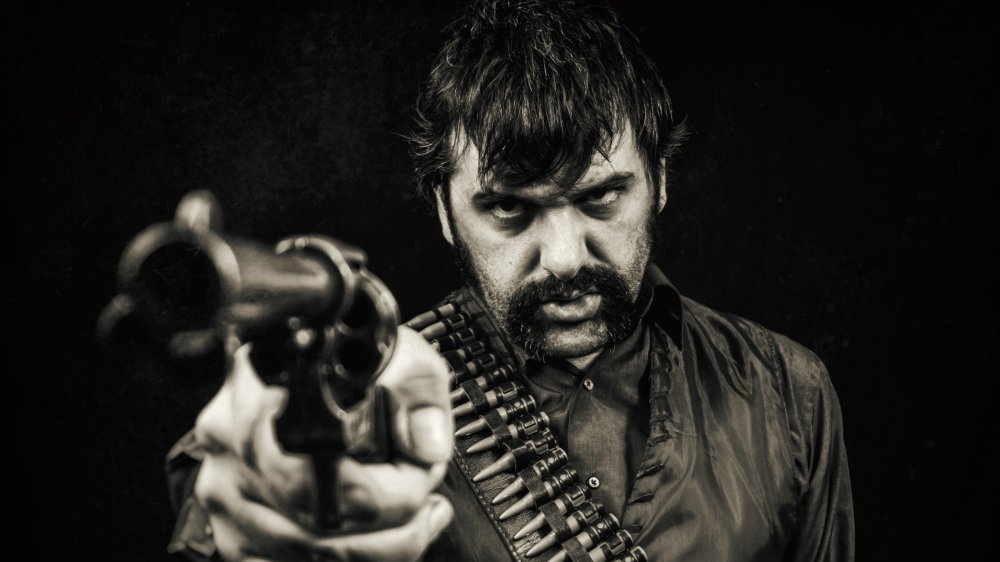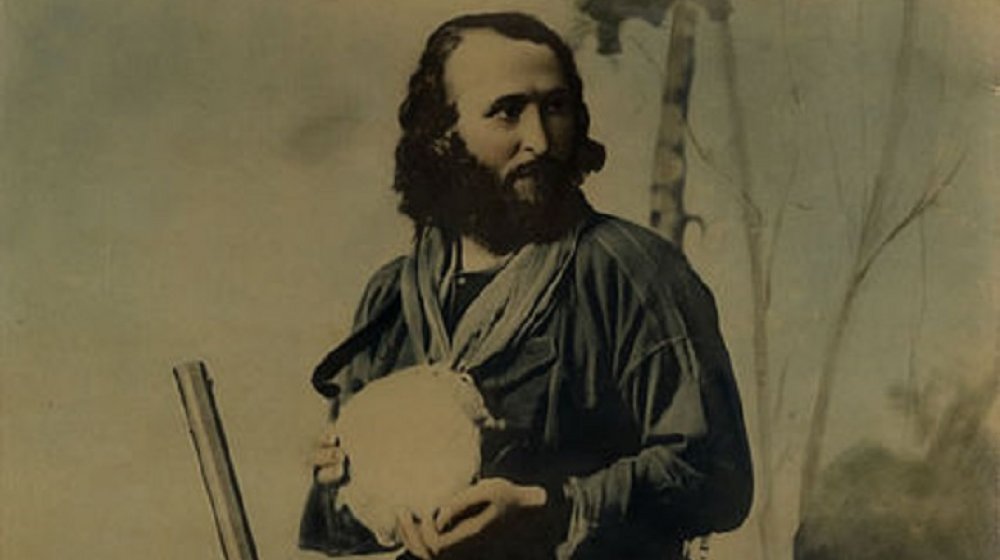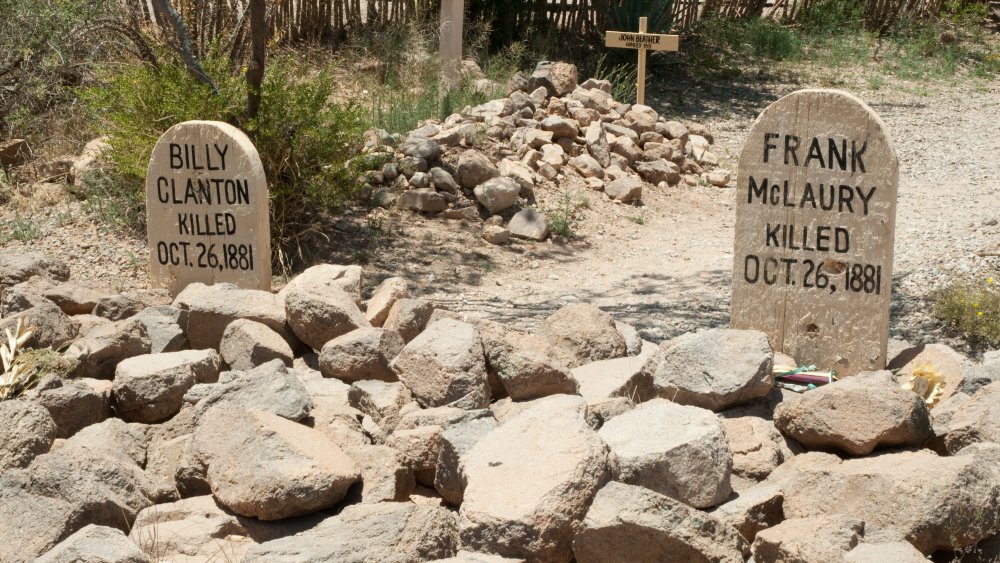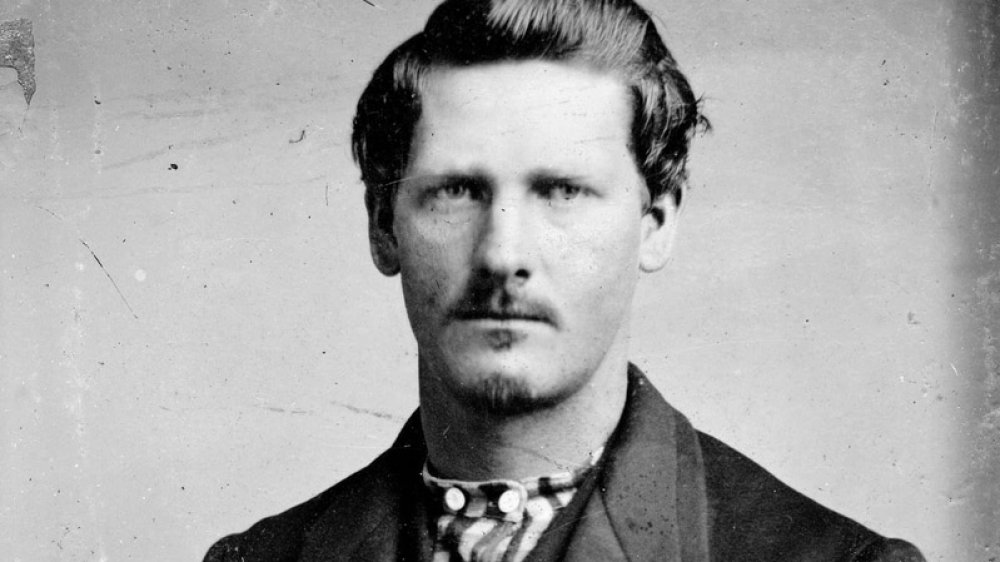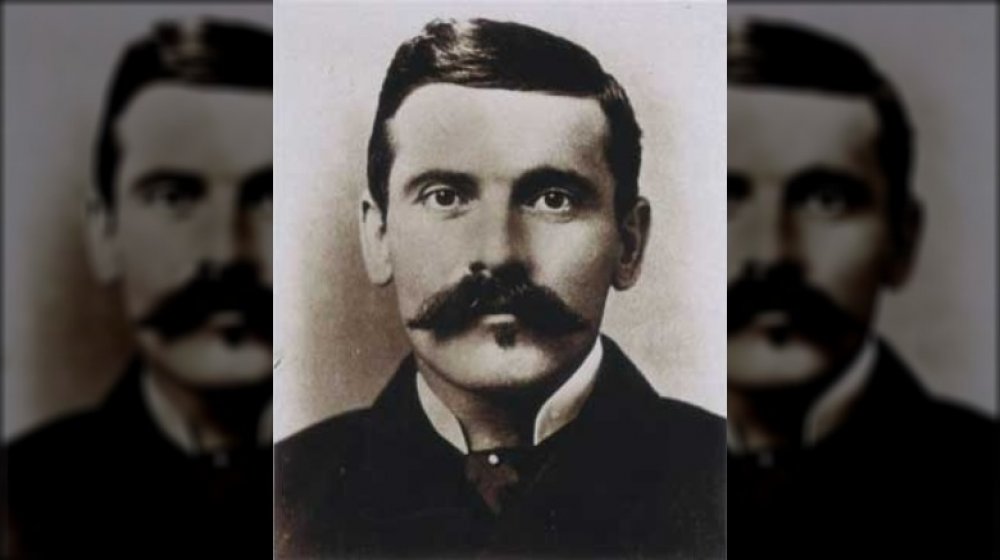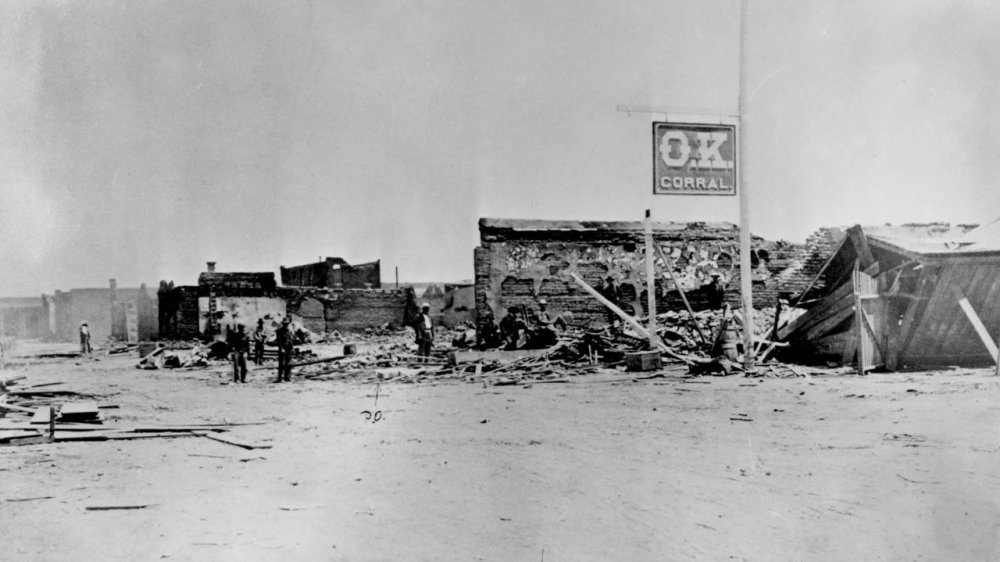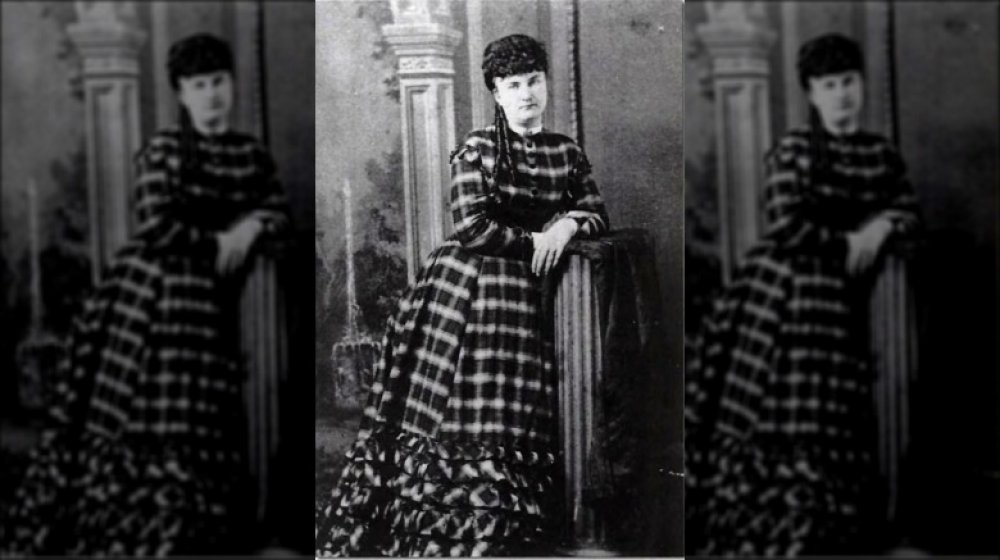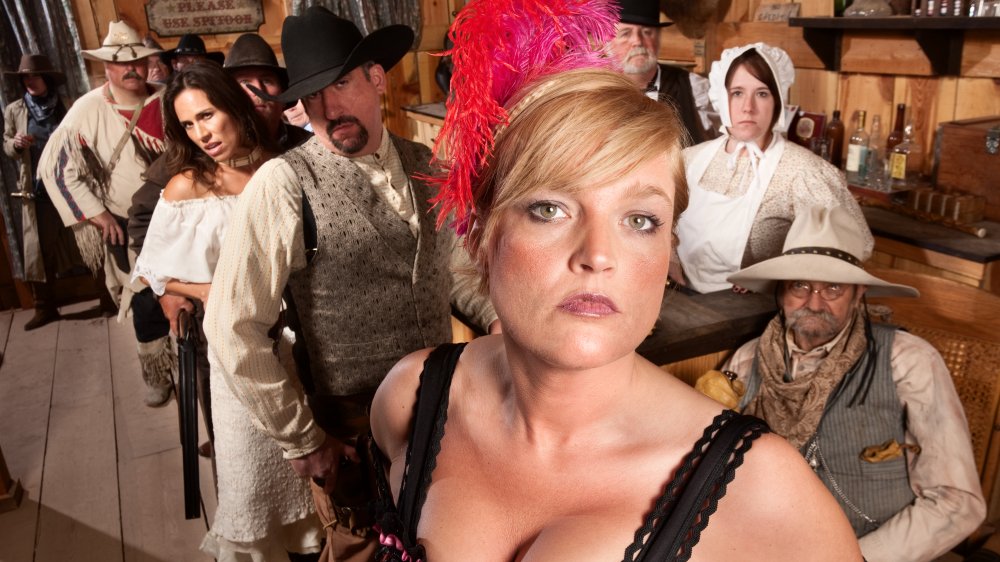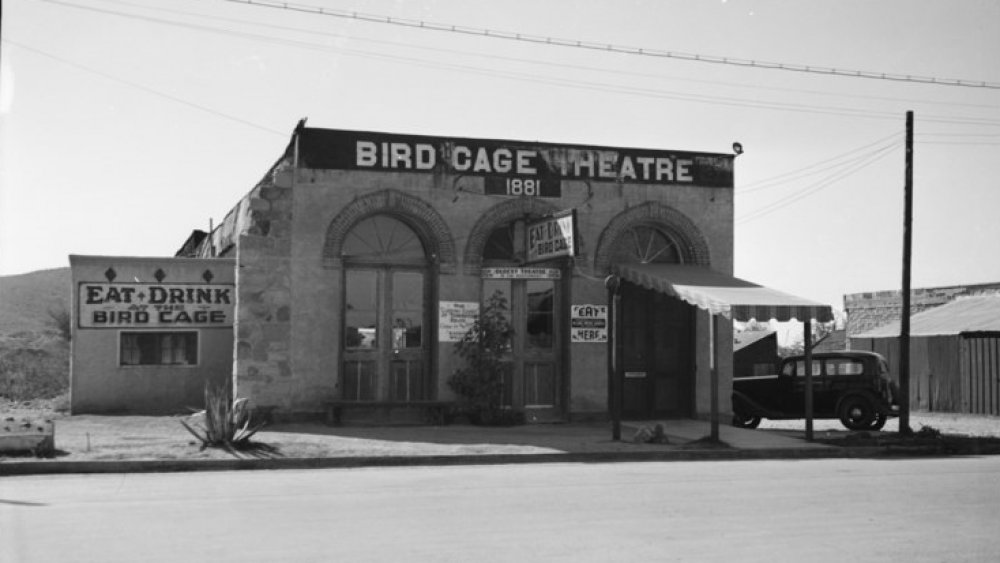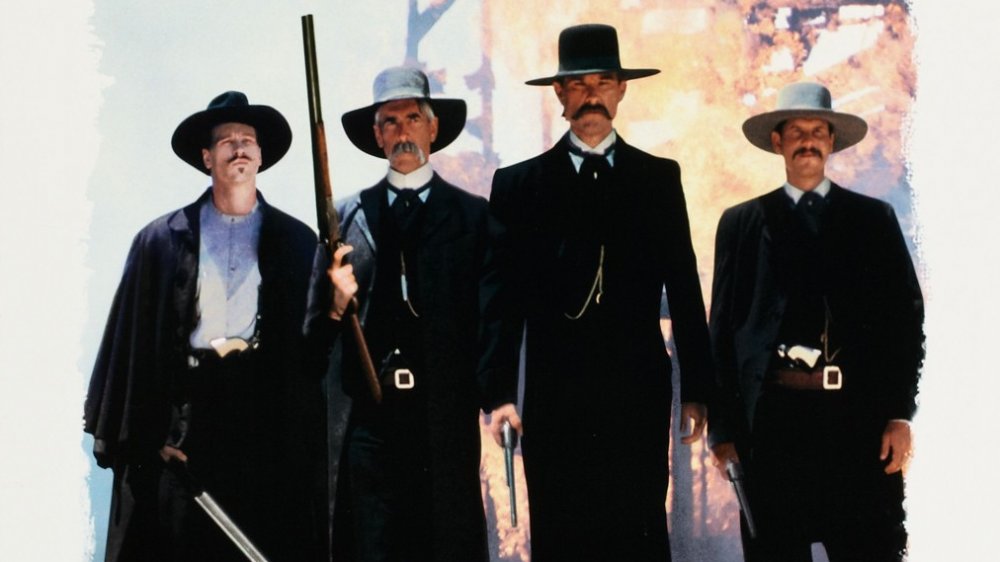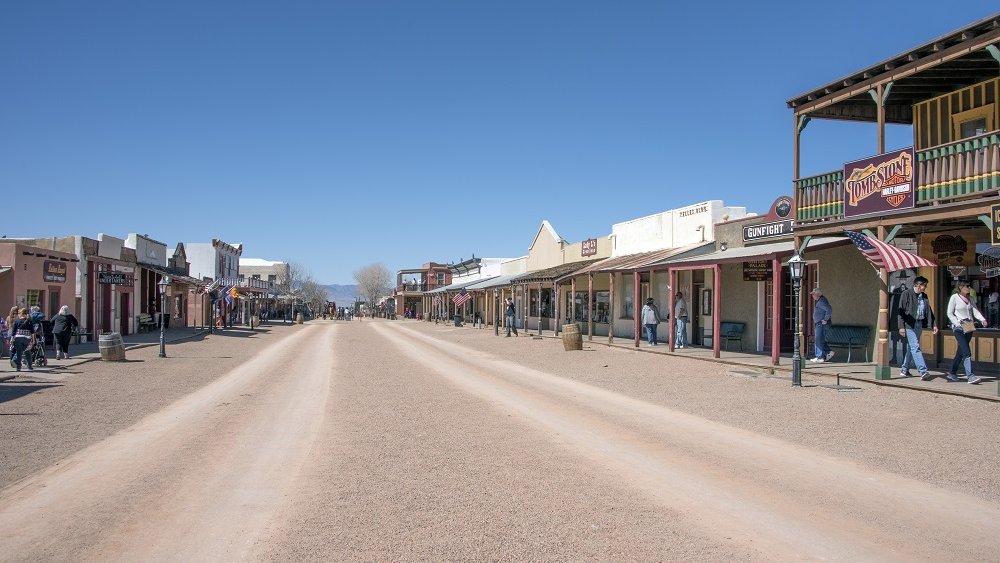The Messed Up History Of Tombstone, Arizona
It's nearly impossible to think of Tombstone, Arizona, without immediately conjuring up images of gunfights and the legendary Earp brothers. But the infamous town had much quieter beginnings. Back in 1877, a silver miner named Ed Schieffelin was making his way into the Dragoon Mountains in southeastern Arizona. The local soldiers told Schieffelin that he was more likely to find his own tombstone before he located any silver, but the hardy miner proved them wrong. Upon striking a rich vein, Schieffelin mockingly named his mine "the Tombstone," and by 1879, a town of the same name had sprouted up near Schieffelin's diggings.
Of course, things quickly took a violent turn. Gamblers, saloon owners, and prostitutes descended upon the fledgling town. And soon enough, Tombstone was put on the map courtesy of the gunfight at the O.K. Corral in 1881. But hold on, pump the brakes for a second. How much of Tombstone's story is actually based in fact? Was it really as crazy as the movies say, or is it all a big Hollywood lie? Well, as it turns out, Tombstone definitely deserves its wild and woolly reputation. And if you want to know more about "the town too tough to die," then grab your six-shooters and get ready for the messed up history of Tombstone.
Tombstone becomes a full-blown town
Even ol' Ed Schieffelin (pictured) must've been surprised that Tombstone grew so quickly. The 1880 census records only 973 people in town, but Tombstone's own website claims there were 4,000 to 5,000 there within a year. The website speculates that "if you take into account the women, children, Chinese, Mexicans and the many 'ladies of the evening,'" the figure could've been in the tens of thousands. In reality, the website puts a more realistic number of people in town between "7,000 and 9,000" people. And the town was growing fast.
As a result, Tombstone's population needed their amenities, like mercantiles, meat markets, churches, schools, and banks. Naturally, intermixed with such businesses were gambling dens, bawdy houses, and over 100 saloons. Naturally, the criminal element was alive and well in Tombstone, what with various outlaws and gunfighters wandering into town. But although such notables as fast-draw outlaw Johnny Ringo made Tombstone their home, the stars of the show were of course Wyatt, James, and Morgan Earp who showed up in 1879, as well as Doc Holliday, who's said to have made his appearance in 1880, according to the Wyatt Earp History Page. And let's not forget Billy and Ike Clanton, Tom and Frank McLaury, and Billy Claiborne, all of whom were at the O.K. Corral shoot-out. In other words, Tombstone was crawling with less-than-reputable figures.
Boothill isn't the only cemetery in Tombstone
Everybody talks about, writes about, and visits Tombstone's infamous Boothill Cemetery, where Billy Claiborne, Billy Clanton, and the McLaury boys are buried along with some 349 other people, according to Findagrave.com. Here, visitors can see the repainted or restored tombstones of folks like Lester Moore, whose epitaph reads, "Four slugs from a .44, no Les, no More." There's even a cool little gift shop where you can buy a commemorative mug or other memorabilia dedicated to cowboys, giddy girls, and outlaws past. What most people don't realize, however, is that the city of Tombstone has another graveyard that's even more authentic and interesting for viewing the final resting places of some 1,400 residents from the past.
According to the Arizona Memory Project, the Tombstone City Cemetery is considered by many to be the town's earliest cemetery, as it dates back to 1840. That means it predates Boothill by about 40 years. Notable figures here include cattleman Joseph Mackey "Mack" Axford and Chief Nino Cochise, a nephew of Geronimo. The cemetery is also home to five outlaws charged with killings in Bisbee, Arizona, and it's also the final resting place of Camillus Fly, the renowned photographer who took pictures of Billy Clanton and the McLaury brothers after they were killed in the O.K. Corral shoot-out. (Fly also became county sheriff in 1896.) It's been a slow process, but Tombstone City Cemetery is slowly gaining some recognition for the notable members of Wild West history who are buried there.
How did Wyatt Earp end up in Tombstone?
Books, magazines, and movies are rife with stories about the life of Wyatt Earp. After all, he was a prominent figure in the incident at the O.K. Corral. But even History submits that Wyatt Earp's reputation "as a virtuous lawman and the best gunfighter in the West" is, in reality, a myth. The simple facts are these: Earp was born in Illinois to itinerant farmers who moved to Iowa. When his first wife died, a grieving Earp left home and went to Kansas, where he fell into the shady side of life and was frequently in trouble with the law. His assistance in tracking a thief won him a job in Dodge City's police department, and he eventually became marshal. Around this time, he also met his lifelong friend, Doc Holliday, as well as his girlfriend, former prostitute Mattie Blaylock.
In 1879, Earp and Blaylock lit out for Tombstone, where Earp's brother, Virgil, was town marshal. Virgil gave Wyatt a job, and soon, the Earps were joined by a third brother, Morgan. Legends of America states that with Virgil as marshal and his brothers as special policemen, the Earps became the law of the land in Tombstone. But Wyatt's life became a mess when, in 1880, he cast off Mattie Blaylock in favor of another woman, Sarah Josephine Marcus. A Jewish actress, Josephine was the girlfriend of Sheriff John Behan. Many historians claim that Josephine also was a prostitute, with whom Behan had been cavorting for years. Either way, it just goes to show that during Earp's time in Tombstone, he wasn't exactly an upstanding do-gooder.
How did Doc Holliday arrive in this Arizona town?
Born in Georgia, the temperamental John Henry Holliday began his adult life as a trained dentist, who unfortunately contracted tuberculosis shortly after hanging out his shingle. According to Biography, Holliday turned to playing cards and a love of guns to pass the time. He'd already committed at least one murder (possibly quite a few more) in Dallas when he met Wyatt Earp in Fort Griffin, Texas. However, some say the two really met in Dodge City, where Doc also played cards, but others assert that Doc definitely met Earp in Texas. Regardless, around this time, he also met the love of his life, a woman who was as spunky and sassy as he was. Her name was Big Nose Kate.
Rumors abound, according to The Vintage News, that Kate originally had a fling with Wyatt Earp back in Dodge City prior to her move to Texas. Kate herself denied this, claiming that she met both Earp and Holliday while working as a prostitute and dance hall girl at a local saloon in Fort Griffin. Holliday had met his match, for every time he decided to throw a rousing fit at his new girl, Kate responded in kind. As tempestuous as the relationship was, neither seemed able to quit the other. Instead, the couple made do by separating frequently. When the Earps breezed through Prescott, Arizona, to convince Holliday to go to Tombstone, Kate went along according to the Western Heritage Center.
The truth about the gunfight at the O.K. Corral
When people think about Tombstone, they think about the gunfight at the O.K. Corral. But what really happened at that fateful shoot-out? Well, according to History, in March 1881, Wyatt was out chasing down some stagecoach robbers (said by most to be Billy Claiborne, Billy Clanton, and Tom and Frank McLaury) when he ran across Ike Clanton. Clanton knew the robbers and struck a deal with Earp, presumably to turn them in. Then he changed his mind. The next thing the brothers Earp knew, they were receiving threats from Clanton and his buddies. In the following months, according to Clanton's testimony, the Earps and Holliday began harassing Billy Clanton and his friends. On October 26, things came to a head with a 30-second shootout that left Billy Clanton and the McLaurys dead. Wyatt and Doc were arrested and a trial was held, then thrown out, and months later, Virgil Earp was wounded, and Morgan was murdered as revenge for the shoot-out.
Today, visitors to Tombstone who visit the reconstructed O.K. Corral get to watch reenactors blow each other into eternity every single day. What many don't know, however, is that the shoot-out, according to National Geographic, actually didn't take place in the corral. Instead, it went down in a vacant lot next to a boarding house where Holliday rented a room. That place was on Fremont Street, now known as U.S. Route 80. Today's O.K. Corral is on Allen Street. In other words, visitors flocking to the scene of the shoot out actually drive right over the original historic spot to get to the O.K. Corral.
The Earps and the ladies of the evening
During the time the Earps and Doc Holliday were in Tombstone, they were active — at least by association — in the prostitution industry. Indeed, Wyatt left a trail of wanton women behind him as he traveled. Earp lived in a brothel in Illinois in 1872-73 (and might have been running the place), when he was arrested for being in a house of ill repute. On top of that, Earp and his buddy, Bat Masterson, were called "the Fighting Pimps" in Dodge City, a nickname Earp took with him when he left town in the company of Mattie Blaylock.
As for Blaylock, she was working as a prostitute herself in the early 1870s. Blaylock was deeply in love with Wyatt, and by 1880, she was identified in the census as his wife. By the time of the O.K. Corral incident, however, Mattie had developed debilitating migraines and become addicted to laudanum. Earp threw her over for Josephine Marcus (another prostitute), and Mattie died in 1888 of an intentional overdose.
James Earp's wife, Bessie, was also a prostitute or madam, hailing from Wichita, Kansas, and she eventually moved with her husband to Tombstone. And even after marrying James in 1873, Bessie continued working as a "sporting girl" in Kansas. Did Bessie continue sporting once they arrived in Tombstone? Nobody really knows, as a prostitution license in Tombstone bearing her name has yet to surface. But then, of course, there's Mary Katherine Haroney, aka Big Nose Kate, who was an even more notorious shady lady working in Tombstone, and who had previously worked for Bessie Earp in her brothel in Kansas.
As for whether or not the Earps and their crew were actually involved in prostitution, Wyatt may have sold a brothel to Tombstone prostitute Dutch Annie. Also, Wyatt seems to have signed off on an astounding number of prostitute licenses in both Dodge City and Tombstone — although as WorthPoint points out, some of them could be fake. Nevertheless, it's widely speculated that the Earps quite possibly oversaw the industry (at least as lawmen).
Other wicked women in Tombstone
If the Earps dabbled in the prostitution industry of Tombstone, they certainly had their hands full. Many a famed harlot made a name for herself in the mining town. According to writer Michelle Floyd, they included such beauties as Dutch Annie and China Mary, who are buried in Boothill Cemetery. China Mary is especially notable since the lady not only maintained control over her own girls but every other prostitutes of Asian descent, as well. These, and many other women like them, worked out of small rooms known as "cribs" or dingy brothels where most made little money.
More upscale bordellos were also available. According to writer Douglas Towne, Tombstone offered an array of bordellos for every man's wallet, from the cribs to fancier parlor houses. The ladies therein paid "fines" to the city for their licenses to operate. There are plenty of prostitute licenses out there signed by Wyatt Earp, some real, some fake. Of the authentic ones, one license is especially interesting because the lady's name on the license is Sadie Jo of the Bird Cage Theater. Historians are divided as to whether Sadie Jo was really Earp's lady, Sarah Josephine Marcus. Author Michael Rutter and plenty of others have verified that Earp was fond of calling the controversial Josephine "Sadie." If Sarah and Sadie Jo were one and the same, Earp had everything to gain and nothing to lose by granting her a license for prostitution.
Tombstone dies ... then sprouts back to life
For about two more decades after the shootout at the O.K. Corral, Tombstone thrived. But all good things must come to an end. According to Tombstone Web, the silver mines around town eventually began flooding after they reached a level of 520 feet below the surface. As the mines closed, folks moved on. The 1900 census records under 700 people left in town. A 1925 film of the town reveals buildings with shuttered doors and broken windows as a handful of folks wander around the town, but it wouldn't be until the late 1950s that the former courthouse finally opened as a museum.
More efforts would come to preserve the town, thanks to the efforts of the Tombstone Restoration Commission. Meanwhile, business owners got to work restoring old business and creating viable ways to bring folks back to town ... in a cheesy sort of way. Writer Paul Trachtman of Smithsonian Magazine recalled visiting the town during the 1970s, "when the swinging doors of the Crystal Palace Saloon were virtually the only ones open, and the O.K. Corral was populated by a mechanical gunfighter with whom, for a quarter, one could try one's luck." Today, noted Trachtman, Tombstone is a glorified version of that mechanical gunfighter, with scads of attractions and colorful storefronts.
Tombstone and its Hollywood persona
Tombstone might never have dusted its old bones off to rise to glory again if it weren't for Wyatt Earp. The famed lawman spent a number of years wandering around the west with Josie Marcus before moving to Los Angeles in 1901. Although he had trouble finding someone to publicize his own adventures, according to History, Earp was able to befriend actors like William Hart and Tom Mix. The guys were all ears as Earp embellished his stories about Tombstone. Before long, Earp was a Wild West hero and welcome sight on L.A. movie sets as a consultant, the man who knew what'd really happened because he was there when it did.
Earp died in 1929, but in the wake of his funeral, dozens and dozens of westerns would come out in the years that followed. Famous actors like Henry Fonda, Burt Lancaster, and James Garner have all played Earp, while Hollywood legends like Victor Mature, Kirk Douglas, and Jason Robards have taken on the mantle of Doc Holliday. In more modern cinema, two films in particular are of interest because they came out so close together. There's 1993's Tombstone starring Kurt Russell and Val Kilmer, and then there's 1994's Wyatt Earp starring Kevin Costner and Dennis Quaid. The premise of both movies is essentially the same, with the Earp boys and Holliday doing their thing at the O.K. Corral with little variance in the story. In the aftermath, the most notable arguments concerning the movies was which was better. However, we've got to side with Tombstone, thanks to Kilmer's show-stealing performance as Doc Holliday, a movie sidekick who definitely doesn't get enough credit.
What's up in Tombstone today?
Tombstone's Chamber of Commerce points out that the Tombstone of today has been a National Historic Landmark District since 1962, a Preserve America Community since 2009, and most importantly, it's "a real community," lest anyone come there in hopes of relieving historic properties of their treasures. Also, metal detecting and treasure hunting is officially off limits, according to a 2011 post in Metal Detecting Forum. Now a bona fide town of the tourist trade, Tombstone continues to be a "film friendly community," where filmmakers are welcome to set up their cameras and tell their own story about what really happened way back when, so long as one procures the proper permits.
As for sites to see, if cheesy is what you want, cheesy is what you'll get. "Enjoyed but pretty commercial," said one reviewer on TripAdvisor, who noted that it was "free to enter the town itself, but to see any attraction or ride the stagecoaches, you were paying individually." Others on the site have also been dismayed at having to pay to really see anything, although several have recommended taking the trolley tour and were happy that dogs were allowed on the ride and in most of the shops. Still, others highly recommended the museums to see the real history. But if you're looking for tacky stores, there are plenty, with names like "Desert Eagle Trading Post," "Fallen Angel Sweet Sin Parlor," and "The Shady Lady's Closet." Fortunately, it seems that the people of Tombstone are incredibly friendly, unlike their gunfighting ancestors.
